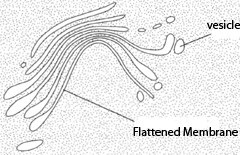Golgi Bodies
Eukaryotic cells regularly contain numerous flattened, saclike structures, which under an electron microscope appear as a stack of pancakes. These are the Golgi bodies. They derive their name from Camillo Golgi (1843-19261, an Italian physician who discovered these structures in 1883, while examining nerve cells of a barn owl. |
| Figure 2-7 Golgi bodies: flattened membranous sacs and vesicle |
Although they are present in all kinds of cells, Golgi bodies appear to be more prominent in cells that produce secretions: and they are always found in association with basal bodies of flagella and cilia, and with centrioles. Figure 2-7 shows that the flattened sacs seem to pinch off little vesicles, which are able to migrate through the cytoplasm and deliver their contents to specific sites. Golgi bodies contain enzymes, and in addition to their role of delivery, they may be involved in manufacturing. They are also believed to play a part in cell plate formation, making microtubules, and synthesizing enzymes. While they are more common in animal cells than in plant cells, they are found in both. They are versatile organelles, performing different functions in different kinds of cells. In an egg cell, for example, they are involved in the production of yolk in an adrenal gland cell, they play a role in making a hormone; and in a salivary gland cell, they participate in making a digestive enzyme. Golgi bodies do what they do in accordance with instructions from nuclear DNA. We know that the nuclei of all kinds of cells are alike, and that, in fact, all nuclei come from previously existing nuclei. So it is a striking feature of nuclear DNA that it is able to give certain instructions and leave other instructions switched off. Thus, in differing cells, the instructions may be different by calling upon different DNA segments.
In plant cells, the Golgi bodies are commonly called dictyosomes. They may make cellulose, and the vesicles associated with them may deliver the cellulose to be deposited in the cell walls. In depositing cellulose in the secondary cell wall, the vesicles that carry the cellulose must pass through the cell membrane. This suggests that they also play a role in cell membrane repair. Proteins manufactured in the endoplasmic reticulum may be passed to the dictyosomes, where they are modified by the addition of sugars or fat groups. These dictyosomes do not reproduce themselves in the way that mitochondria and chloroplasts do. Rather, at the time of mitosis, the dictyosomes fragment into fine granules, which are then distributed to the daughter cells.
If the contents of the vesicles are digestive enzymes, the vesicles are called lysosomes. The enzymes are believed to be manufactured in the endoplasmic reticulum and passed on first to the Golgi bodies and then to the lysosome vesicles. The lysosome vesicles may then either rupture within the cell, where the release of enzymes would result in the dissolution of the cell, or migrate outside of the cell, where they will rupture and release the enzymes. Because such events appear to be more often associated with animal cells, they will not be elaborated on here.




